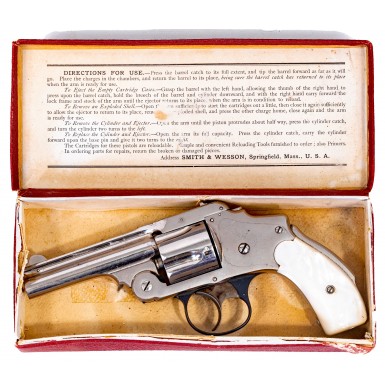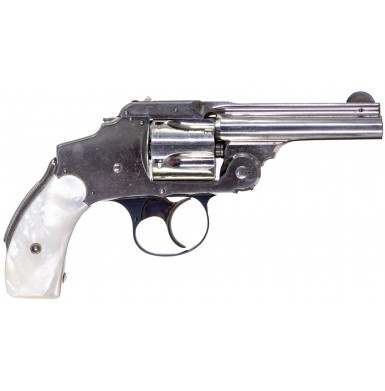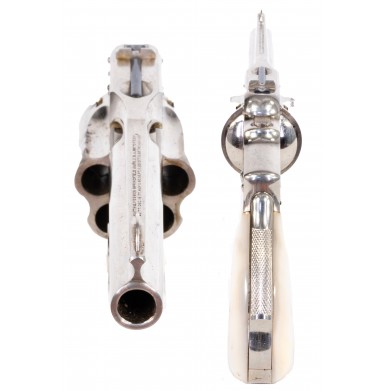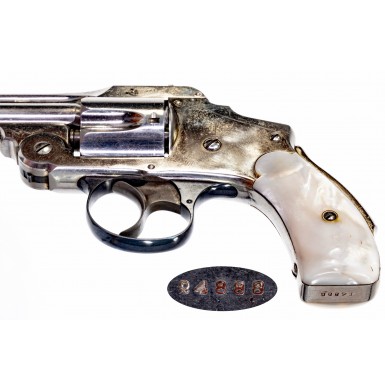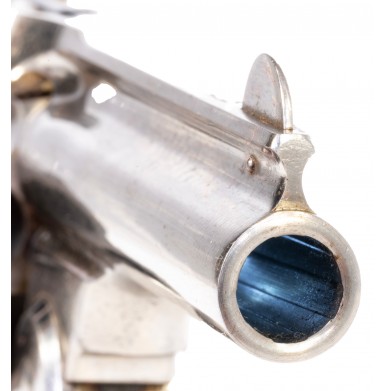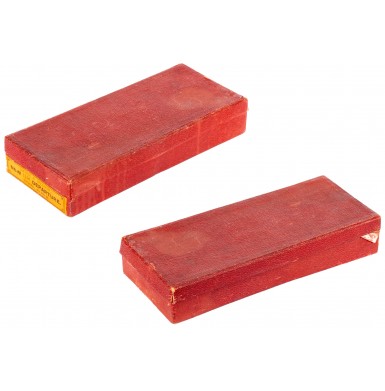Smith & Wesson 2nd Model New Departure "Safety Hammerless" .38 S&W Revolver in Factory Box
- Product Code: FHG-LG184
- Availability: Out Of Stock
-
$1,295.00
In 1870 Smith & Wesson revolutionized the American handgun market with the introduction of their Model No. 3 Single Action Revolver. Not only was this the first revolver that Smith & Wesson had introduced in a substantial caliber, .44 American, it also introduce the tip-down barrel with simultaneous extraction mechanism that would come to define the large majority of Smith & Wesson revolver production until the end of the 19th century. As with most American handgun makers, the firm initially concentrated on designing firearms that might be adopted by the US military, the single largest gun buyer in America. Smith & Wesson did manage to sell 1,000 of their new revolvers to the US Government, where they became the first centerfire metallic cartridge revolvers to be issued to the US cavalry. While the design was not adopted, losing out to the Colt Single Action Army revolver in 1873, Smith & Wesson did manage to sell some 8,285 of their improved “Schofield Model” revolvers to the US Government, including 3,000 1stModel and 5,285 2nd Model guns. All of these initial Model No. 3 based revolvers were large bore, six-shot single action handguns chambered for either a form of a S&W .44 caliber cartridge or the .45 S&W Schofield. Eventually the descendants of the Model No 3., including the New Model No. 3 became relatively successful in both their “American” and “Russian” variants, with most sales in the US being commercial, but with foreign sales to the militaries of Russia, Japan, Turkey, Australia and Argentina making it one of the most widely used revolver designs around the world.
In 1876 Smith & Wesson officially entered the smaller frame civilian handgun market with the introduction of their Model No. 2 “Baby Russian” Revolver in .38 S&W. These were scaled down versions of the larger New Model No. 3 Revolver and retained the tip-down barrel and simultaneous extraction mechanism, but on a much smaller frame with a five-shot .38 S&W fluted cylinder and a spur trigger. Like their predecessors, the revolvers remained single action handguns. The smaller guns were perfect for discreet carry in civilian clothes and were produced with 3 ¼” and 4” ribbed round barrels. Like most Smith & Wesson revolvers of the era they were available in blued or nickeled finish with color casehardened hammers and triggers and blued screws and small parts. Checkered hard rubber S&W monogramed grips were standard on nickel guns with wood standard on blued ones, but exotic grips such as ivory and mother of pearl were available for an additional charge. These guns were very successful and more than 160,000 of the small frame single action .38 S&W revolvers were produced between their introduction and 1911, in three major model revisions.
In 1877 Colt introduced their first line of double action revolvers, with the .38 Colt “Lighting” and .41 Colt “Thunderer” being the initial offerings and later adding the .32 Colt “Rainmaker”. These smaller frame revolvers had a bird’s head grip and were scaled down for easy civilian carry, with the shortest barreled versions being perfect for discreet, concealed carry. The following year Colt introduced their large frame Model 1878 Frontier double action revolvers, with these guns offered in the popular large frame handgun calibers of the period, including .45 Colt, .44-40 and .38-40. Smith & Wesson was behind the eight-ball now and increased their efforts to introduce a double action handgun to compete with the Colt designs.
In 1880, Smith & Wesson introduced their new double action handgun design. The initial offering was a small frame 5-shot .38 S&W revolver. The following year, much like Colt, a large frame 6-shot revolver was also introduced in three calibers .44 S&W Russian, as well as .44-40 and .38-40. These revolvers were intended to compete with the comparable Colt offerings. Like the Colt designs, these revolvers were conventional double action designs, with the ability to fire the gun with a long, heavy double action pull or to manually cock the hammer for a lighter single action pull. The Smith & Wesson design did offer a significant speed difference when loading and unloaded due to their break open, simultaneous extraction design. The Colt revolvers were built on a solid frame and loaded and unloaded through a loading gate on the right-hand side, like the Single Action Army revolvers did. These smaller framed double action .38 S&W revolvers were wildly successful and from the time of their introduction, through the end of production in 1911, the firm produced more than a half-million of the handguns. When compared to the total of roughly 166,000 Colt Model 1877 revolvers which these guns competed with the, the Smith & Wesson design was roughly three times as popular.
Not to rest on their laurels, and in hopes of expanding their market and success even further, in 1887 Smith & Wesson introduced their S&W .38 Safety First Model Double Action Revolver. Known in their marketing campaign as the “New Departure .38 Safety” or by the nicknames of “Safety Hammerless” and “Lemon Squeezer”, the gun introduced some new features to the personal defense handgun that remain in use to this day. The most immediately obvious was the concealed hammer design, with no external hammer visible or hammer spur to cock. This also meant that by default the lock work was “double action only” with no facility to cock the gun and fire it with a lighter single action trigger pull. Concealed hammer was not a true innovation, as during the Civil War era the Raymond & Robitaille designed Pettengill series of revolvers utilized concealed hammers and double action only lock works. The Pettengill design was not popular, and the .44 caliber guns purchased by the government performed poorly in the field, causing most to be withdrawn from service. However, the refined Smith & Wesson design functioned much better than the earlier Pettengill. To this day, Smith & Wesson offers concealed hammer double action only revolvers for self-defense, primarily in their “Centennial” line of handguns. The second major innovation was somewhat unique and would revolutionize the handgun industry, the introduction of a grip safety. The spring-loaded safety bar on the rear of the grip strap prevented the revolver from being fired unless it was depressed. This design was so successful that it remains in use to this day on such venerable designs as the Colt 1911 pistol and its clones. A change was also made in the release mechanism for the top-break, tip-down, simultaneous extraction handgun. A “Z” shaped release was added to the top rear of the frame, requiring a sideways push to unlock the topstrap and release the barrel to be tipped down. Like the conventional double action handguns in the line, the guns were produced with 5-shot fluted cylinders and were offered with blued or nickel-plated finishes and checkered hard rubber S&W monogram grips as standard. The ribbed round barrels were offered in 3 ¼”, 4” and 5” lengths, with a small number produced with 6” barrels as well. Sights were rudimentary at best, with fixed notch rear sight at the top of the frame post that the topstrap locked against and a pinned round blade front sight. A total of 5,125 of the initial First Model S&W .38 Safety Hammerless Revolvers were produced that year but were soon superseded by the improved Second Model S&W .38 Safety Hammerless Revolvers. The primary improvement in the 2nd Model design was replacing the “Z” shaped, side-push barrel catch with a push button release in the middle of the rear of the topstrap. This made the opening of the revolver much easier and far more ergonomic.
As with the First Model guns, the Second Model guns were double action only revolvers with a top-break, tip-down barrel mechanism that featured automatic simultaneous extraction. They had five chambered fluted cylinders and rudimentary fixed sights. Finished were either blued or nickeled with color casehardened triggers, blued triggerguards and some blued small parts. The ribbed round barrels were offered in 3 ¼”, 4” and 5” lengths, with a small number produced with 6”. The revolvers were serial numbered in the continuation from the First Model range, starting in the low 5,XXX range and continuing through 42,483 before the design was changed again in 1890 and the Third Model S&W .38 Safety Hammerless Revolvers replaced the Second Model. During the period of production from 1887-1890 some 37,350 .38 S&W Second Model guns were produced. In 1888, a .32 S&W version of the revolver was also introduced, but on a slightly smaller frame.
Most interestingly, while certainly not conceived of as a military revolver and while the .38 S&W cartridge could hardly be described as a “combat” cartridge, the US Government acquired 100 of the guns with 6” barrels for testing in 1890. The guns were pitted against the newly adopted Colt Model 1889 revolver in a variety of tests and in many ways fared better than the Colt. The Smith & Wesson revolver was more accurate than the Colt and the Smith & Wesson could be loaded and fired more quickly with its break open design than the new Colt swing out cylinder. The .38 S&W cartridge was not as powerful as the .38 Colt cartridge, but neither was particularly powerful, even by the standards of the time. In the end the Smith & Wesson design fared worse during the part of the testing that exposed the guns to severe conditions and intentional abuse. Two mainsprings broke during testing and while neither gun was 100% reliable, the more complicated and somewhat delicate mechanism lost out to the Colt design.
In the end the Smith & Wesson .38 New Departure “Safety Hammerless” revolver would remain in production for over 50 years, right up until the eve of World War II. During that time roughly a quarter million of the .38 S&W revolvers were produced. Like most Smith & Wesson products, it went through a number of improvements and versions with the 5th Model being the last variant, which went into production in 1907 and remained in the product line until it was discontinued in 1940.
The revolver offered here is an about EXCELLENT condition example of a Smith & Wesson .38 Second Model New Departure “Safety Hammerless” Revolver. The gun is a nickel finished gun with lovely period mother of pearl grips and retains a period Smith & Wesson cardboard box with a textured maroon exterior and an orange end label. The gun has a 3.25” ribbed barrel is 7 ¾” in overall length and has the usual five-chambered fluted cylinder. The revolver is serial number 24888, which is clearly stamped on the butt and with the matching serial number on the rear face of the cylinder. The rear sight is a fixed notch at the top of the frame post to which the topstrap locks, and the front sight is the usual round blade that is pinned in place. The two-line barrel address reads:
+SMITH & WESSON SPRINGFIELD MASS. U.S.A. PAT’D FEBY+
20. 77. DEC. 18. 77. MAY 11. 80. SEPT. 11. 83. OCT. 2. 83. TWO AUG. 4. 85
The address and patent information are flanked by a pair of Maltese Crosses.
The pistol remains in EXCELLENT condition and retains about 90%+ of the original nickel finish with some scattered minor surface freckling and a few very tiny areas of minute flaked loss and some areas where the nickel has dulled to a milky color. The most noticeable flaked loss is along a couple of the cylinder flutes, where the underlying metal has oxidized to a dark brown color. There is some minor bubbling on the left sideplate, which is not really that noticeable, and there is some lightly scattered freckling and tiny areas of minor surface oxidation that are scattered around the gun. The blued triggerguard retains 90%+ of its original bright blue, and the frame catch and spring in the topstrap retain a similar amount of blue, although they have a duller appearance. The trigger retains about 70% of its color casehardened finish with dulling and fading and is only about 40% vivid, mostly on the web nearest the trigger face. The two-piece mother of pearl grips are in EXCELLENT condition as well and fit wonderfully. They show good age and have certainly been with this gun since the period of use. They are unmarked on their interiors but are almost certainly factory grips. The grips show a couple of lightly scattered minor handling marks and a couple of minor surface scuffs that are lightly discolored but somehow have escaped the nearly ubiquitous chips and cracks that mother of pearl grips almost always have. The bore of the revolver is EXCELLENT as well and is almost entirely bright with only a couple of lightly scattered patches of minor surface oxidation and discoloration. The rifling is equally excellent and even the chambers are bright and shiny. The revolver is also in EXCELLENT mechanical condition and functions correctly in every way. The revolver times, indexes and locks up exactly as it should. The top break action functions correctly as well and locks tightly together with no wobble and the extraction mechanism works correctly as well when the barrel is pushed down.
The gun is accompanied by an original Smith & Wesson factory pasteboard box with a textured maroon colored exterior and an orange end label that reads:
SMITH & WESSON,
NEW 38 DEPARTURE.
NICKEL. 3 ¼ INCH.
The inside lid of the box is printed with the instructions for the operation of the revolver. The box shows moderate wear and damage with some separations at the corners, wear to the hinge, numerous scuffs and moderate surface loss and some loss to the printing on the interior of the lid. However, given the age of the box, circa 1888-89 it remains in very nice condition and boxes like this are not often found with the guns.
Overall, this is a really outstanding condition example of a groundbreaking Smith & Wesson revolver. The concept of the “Safety Hammerless” remained a part of the Smith & Wesson product line well into the 20th Century and to this day they offer double action hammerless revolvers. The gun is in an outstanding state of preservation, wears what are almost certainly a set of factory mother of pearl grips and is mechanically excellent. The accompanying box is a very nice addition to the display of the gun as well. This is great addition to any Smith & Wesson collection and is in the condition that will make nearly any collector quite happy. It would also be a nice addition to any collection of late 19thCentury American handguns and would be equally at home in a collection that focuses on the end of the Old West, the Prohibition Era, the birth of organized crime, or any other important historical events in the United States during the 1880s to 1920s.
Tags: Smith, Wesson, 2nd, Model, New, Departure, Safety, Hammerless, 38, SW, Revolver, in, Factory, Box


